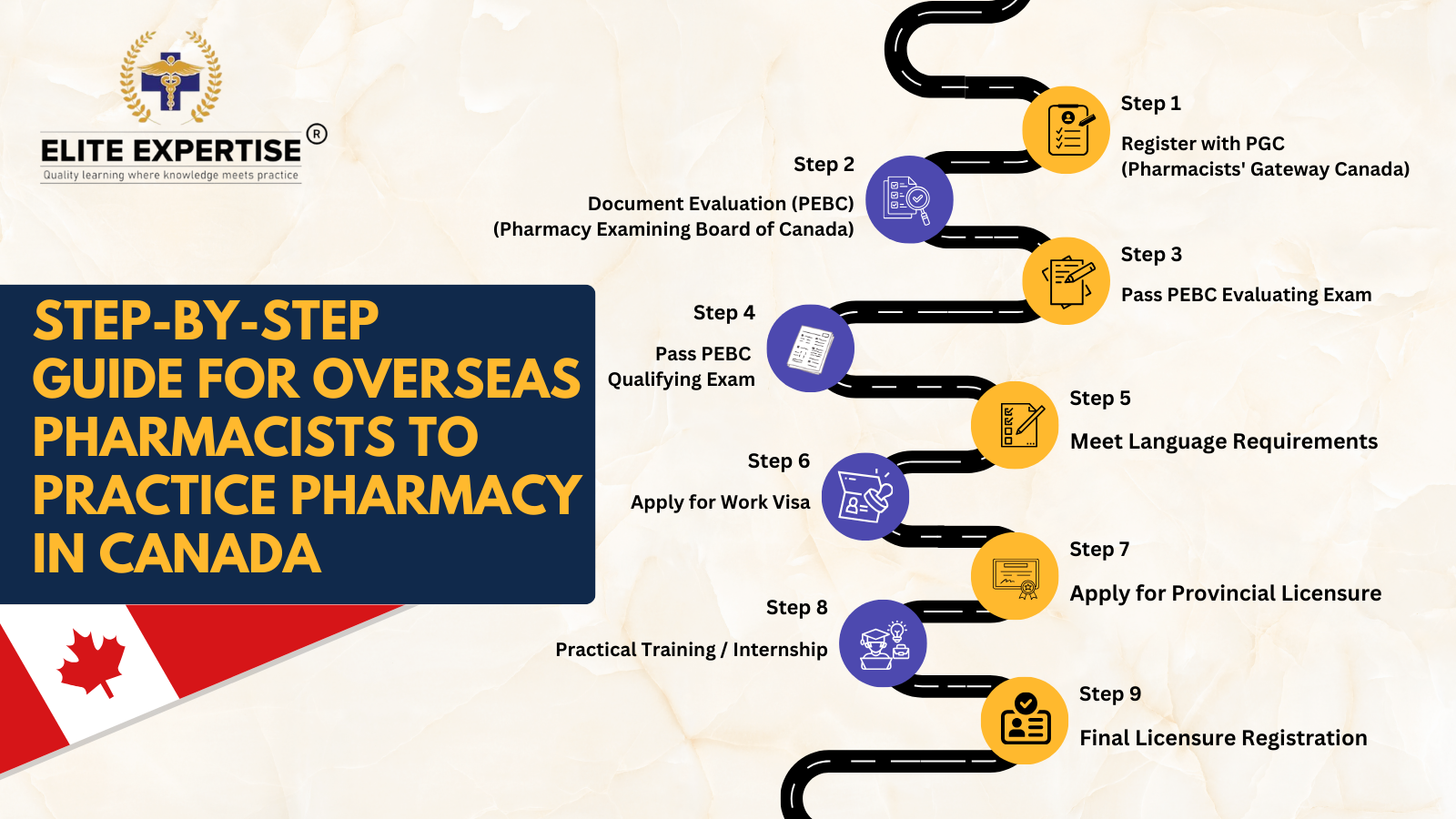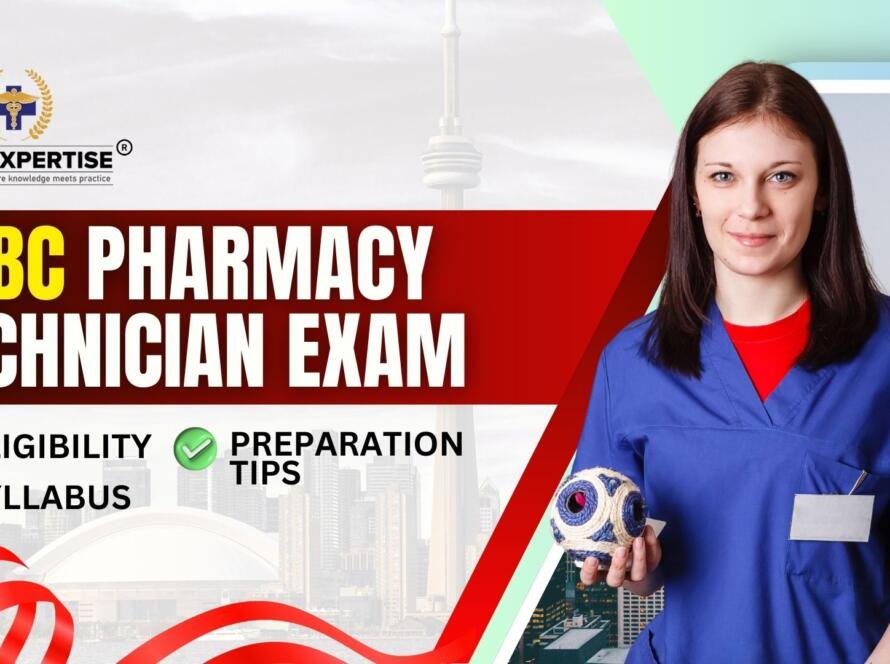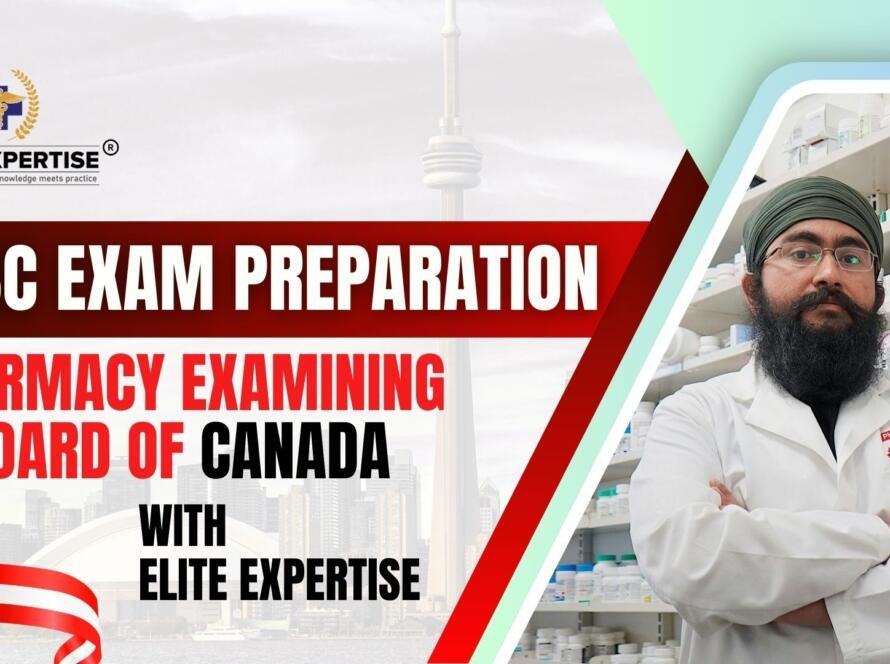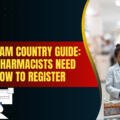|
Getting your Trinity Audio player ready...
|
Table of Contents
ToggleThe pharmacy is a strong pillar in Canada’s healthcare system. Pharmacists are responsible for clinical advice, good communication with other medical professionals, safe medication dispensing, and improved public health through immunisation and disease prevention initiatives. The country’s aging population poses pressure on the increasing demand for pharmacists and health care workers in different provinces and territories.
Canada provides many opportunities for better careers to foreign-graduated pharmacists. To ensure that only qualified and able workers make the cut, an extremely regulated and systematic procedure is implemented. The pharmacy licensure procedure implemented by Canadian national and provincial regulatory agencies is systematic and comprehensive.
Also Read: Why Canada is the Top Choice for Overseas Pharmacists?
The Pharmacy Examining Board of Canada (PEBC) is the official certifying organization for this process. The PEBC’s job description includes evaluating pharmacists’ skills and credentials, whether they graduated internationally or locally. Becoming a licensed pharmacist in Canada is a complete procedure that includes several steps; each step is required to guarantee patient safety, consistency, and professionalism across the country.
This blog explains the whole process, including exam preparation, relocation, visa and immigration, and the licensing process.
Also Read: Know About the PEBC Exam Fees and How are they Structured
What is PEBC, and Why is it Important to Become a Pharmacist in Canada?
The PEBC is the official certification body of Canada and is responsible for evaluating internationally trained pharmacists’ qualifications and skills. PEBC maintains equal academic and professional standards for all pharmacists, regardless of their educational background. Canadian provinces and territories require PEBC certification of pharmacists to issue licenses. International pharmacy graduates (IPGs) cannot practice pharmacy in Canadian lawfully without PEBC accreditation. PEBC impartially evaluates pharmacists’ knowledge, skills, and decision-making abilities by conducting numerous document assessments and standardised exams.
What are the Steps Involved in PEBC Certification Process?
PEBC certification is a multi-step, standardised process and is compulsory for every pharmacist seeking to start their practice in Canada.
Registration with Pharmacists’ Gateway Canada (for IPGs): Obtain a National ID number before applying for PEBC certification examinations.
Document Evaluation (for IPGs): Verify academic credentials and pharmacy degrees.
Evaluating Examination (for IPG): Assess the pharmaceutical knowledge of pharmacists for pharmacy practice.
Qualifying Examination (for all graduates): To obtain final certification, a two-part licensing exam (MCQ + OSCE) is necessary.
Admission Process & Eligibility Criteria
PEBC and Canadian pharmacy regulatory authorities established a formal admission procedure and set specific standards for pharmacists to fulfil to establish a pharmacy career.
Eligibility Criteria
Eligibility criteria for IPGs
- Completed a four-year undergraduate pharmacy degree from a recognised university in your home country.
- Register with Pharmacists’ Gateway Canada before submitting a PEBC application.
- All academic and professional credentials are submitted for PEBC evaluation.
- After document evaluation, pass the PEBC Evaluation Examination.
- After passing the PEBC Evaluation Examination, apply for the PEBC Qualifying Examination (Part I: MCQ and Part II: OSCE).
Eligibility criteria for Canadian Graduates
- Enrolled in the final year or graduated from a CCAPP-accredited pharmacy program.
- Apply for the PEBC Qualifying Examination (Part I: MCQ and Part II: OSCE), as document evaluation is not necessary for the PEBC Evaluating Examination.
Admission Process
- Sign up with Gateway Canada for Pharmacists
- Send in your paperwork for the PEBC Credential Assessment
- Apply for the PEBC Evaluating Examination
- Sign up for the Qualifying Exam’s Part I (MCQ) and Part II (OSCE)
- Scores from Secure Language Proficiency Tests
- Apply for a visa and migration
- Get a Provincial Licensure Application
- Structured Practical Training and Assessment
- Licensure Registration
Step-by-Step Guide for Overseas Pharmacists to Become Licensed in Canada

Step 1: Enrol in Pharmacists’ Gateway Canada
Before interacting with PEBC, IPGs must register with Pharmacists’ Gateway Canada (PGC). The National Association of Pharmacy Regulatory Authorities (NAPRA) is the governing body for Pharmacists’ Gateway Canada (PGC), which officially allows pharmacists to enter Canada’s pharmacy licensure system.
- Pharmacists’ Gateway Canada(PGC) issues a distinct National ID number required for correspondence and upcoming applications with regulatory bodies in Canada.
- Pharmacists’ Gateway Canada (PGC) gives brief details about the licensing requirements of each province and territory.
- Pharmacists’ Gateway Canada (PGC) centralises applicant profiles, documents, and progress reports.
Process:
- Register on the Pharmacists’ Gateway Canada (PGC) website.
- Fill in the necessary personal and professional data.
- Pay the registration cost.
- Fees: $385 + applicable taxes
- You’ll get a National ID number.
Also Read: Steps Involved to Become an International Pharmacist in Canada
Step 2: Document Evaluation by PEBC
Candidates must submit their documents for evaluation to PEBC, which will confirm their legitimacy and equivalency in Canada’s health care system.
Required Records:
- Degree Certificate (Bachelor of Pharmacy or PharmD)
- Official Academic Transcripts (sent directly from the university)
- Proof of Professional Licensure or Registration (current or past, if applicable)
- Government-Issued Photo ID
- Passport-Size Photographs
- Fees: $715
- Processing Time: Average period of 12–16 weeks
- Outcome: After acceptance, they can apply for the PEBC Evaluating Examination
Step 3: Pass the PEBC Evaluating Examination
The Evaluating examination is designed to compare foreign graduates against Canadian academic and professional standards based on their pharmaceutical knowledge.
- Format: 140 multiple-choice computer-based questions at accredited testing locations
- Duration: 3.25 hours long, and you have to arrive 30 minutes before the time of the examination.
Important Subjects: (Revised blueprint)
- Science of Pharmaceuticals(25%)
- Practice of Pharmacy (55%)
- behavioural, social, and administrative pharmacy sciences (20%)
- Fees: $910
- Outcome: Successful candidates move on to the next phase, which is the PEBC qualifying examination.
- Unsuccessful candidates can apply for retakes up to 3 times.
Also Read: PEBC Latest Update on Evaluating Exam: What You Need to Know
Step 4: Complete the Pharmacist Qualifying Examination
It is the last comprehensive evaluation examination, which is further divided into two sections:
Part I: Examining Multiple Choice Questions (MCQ)
- Purpose: The pharmacists are evaluated based on their clinical problem-solving, decision-making, patient care techniques, and advanced pharmaceutical knowledge.
- Format: 300 multiple-choice questions
- Duration: 4.5 hours, and you have to arrive 30 minutes before the time of the examination.
- Fees: $855
Also Read: Important Subjects to Refer for PEBC Qualifying Exam
Part II: The OSCE, or Objective Structured Clinical Examination
- Purpose: The goal is to evaluate pharmacists’ practical clinical competence, professional communication, and patient contact.
- Format: A series of timed stations. Each station has simulated scenarios mimicking real-life clinical situations, and you have to interact with standardised patients or standardised clients.
- Duration: Approximately 6.5 hours.
Station types:
Tasks:
- Taking patient history
- Counselling patients on medication use
- Solving clinical problems
Skills Assessed:
- Communication
- Clinical problem solving
- Decision making
- Fees: $1915
- Outcome: After passing, receive your Certificate of Qualification from PEBC.
Also Read: Key Tips & Best Practices for Preparing for the PEBC Exam
Step 5: Meet Language Proficiency Requirements
IELTS Academic: Minimum overall 7.0 score and no score below 6.5 in individual bands.
TOEFL IBT: Speaking: 27, Writing: 25, Total: 97
MELAB: Speaking: 3+, Writing: 82, Total: 85
CanTEST: Speaking: 4.5, Writing: 4.5
French
- TESTcan: Minimum score of 5 in each category.
- Quebec:
- Three years of full-time secondary or post-secondary instruction in French.
- Completing fourth or fifth-year secondary-level exams in French as the first language.
- Secondary school certificate in Quebec from or after the 1985-86 school year.
- Certificate issued by the Office québécois de la langue française or equivalent.
Process:
- Select the language test based on the requirements of the province of your choice.
- Schedule and take the test. Check the validity period of the test.
- Upload results on the Pharmacists’ Gateway Canada (PGC) profile or send them directly to the provincial regulatory authority.
Also Read: Language Proficiency Requirements for Pharmacy Licensure in Canada
Step 6: Visa and Migrating to Canada
After passing the PEBC examinations, the next phase is to obtain work authorisation and initiate immigration to Canada.
Documents Required:
- PEBC published the ECA report
- A current passport
- Evidence of PEBC exam results and qualifications
- Results of language tests
- Certificates of police clearance
- Evidence of funds (under the standards of the immigration program)
Common Immigration Initiatives:
Federal Skilled Worker Program Express Entry:
In Canada, pharmacists are classified as skilled workers under the NOC (National Occupational Classification) code 31120.
PEBC issues Educational Credential Assessment (ECA) reports to applicants following credential evaluation.
Program for Provincial Nominees (PNP): Several provinces provide PNPs and prioritise pharmacists because of local demand.
Temporary Foreign Worker Program (TFWP):
- If you have a job offer but are not a permanent resident, you can apply for a work permit under TFWP via Immigration, Refugees and Citizenship Canada (IRCC).
- It requires a Labour Market Impact Assessment (LMIA) from your employer.
Step 7: Apply for Provincial Licensure
Canada has separate pharmacy governing bodies (College of Pharmacists or Pharmacy Regulatory Authority) for each province and territory, and candidates must apply for licensure in the province of their choice. Each Pharmacy regulatory authority has its requirements, such as practical training, Jurisprudence examination, licensure, and registration fees.
Basic Required Documentation:
- Complete application for provincial licensure
- PEBC Qualification Certificate
- Results of language tests
- Certificate of police clearance
- Completion of jurisprudence examination
- Payment of licensure and registration fees
Some Major Provincial Licensing Authorities
- Ontario: Ontario College of Pharmacists (OCP)
- British Columbia: College of Pharmacists of BC
- Alberta: Alberta College of Pharmacy (ACP)
- Nova Scotia: Nova Scotia College of Pharmacists
- Manitoba: College of Pharmacists of Manitoba
Jurisprudence Examination: Most provinces require applicants to pass the Jurisprudence examination to assess their:
- Understanding of pharmacy laws
- Ethical standards for pharmacists
- Professional responsibilities and codes of conduct
- Legal requirements for pharmacy operations.
Step 8: Structured Practical Training and Assessment
Prior to a pharmacist being fully licensed under the guidance of a certified Canadian pharmacist, most provinces and territories require IPGs to complete structured practical training or internship periods. The duration usually varies based on the province. The goal is to introduce:
- pharmacy practice standards,
- prescription dispensing protocols,
- pharmaceutical care planning,
- healthcare legislation.
Step 9: Licensure Registration
It is the final formal step for pharmacy graduates to practice in any Canadian province legally. Each provincial regulatory authority has its requirements and process for work on licensure registration, which is guided by the National Association of Pharmacy Regulatory Authorities (NAPRA).
Key requirements:
- PEBC Qualification Certificate
- Results of language tests
- Completion of jurisprudence examination
- Structured Practical Training (SPT)
- Certificate of police clearance
- Payment of licensure and registration fees
Renewal: You must apply for license renewal each year to a relevant provincial regulatory authority.
Role of Elite Expertise in PEBC Exam Preparation Course
Many foreign pharmacists enrol in PEBC exam preparation classes with Elite Expertise to increase their chances of taking the exam on their first attempt. Elite Expertise is one such reputable choice that offers knowledgeable instructors and evidence-based materials for PEBC applicants. Usually, these classes provide:
- They comprehensively explain the PEBC examination curriculum.
- They organise simulated OSCE stations and mock exams to let you prepare for actual examinations.
- They can design individualised study schedules solely based on your needs and demands.
- They guide you on ethics, pharmacotherapy, and jurisprudential areas of knowledge.
Conclusion
As a graduate with an overseas education, becoming a certified pharmacist in Canada is a fulfilling but challenging journey that requires dedication, careful planning, and rigorous adherence to formal procedures. The pathway is purposefully designed to guarantee that all practising pharmacists protect public health and maintain the quality of healthcare in Canada.
Pharmacists should meet consistent clinical competence, knowledge, and professional ethics criteria, regardless of where they received their education. PEBC and other regulatory authorities devised a transparent and open procedure for foreign pharmacists. Each step is fair, merit-based, and intended to hold high standards for Canada’s healthcare system. International pharmacy professionals can significantly contribute to Canada’s healthcare system by confidently pursuing their goals and establishing a fulfilling pharmacy career in one of the most prestigious healthcare environments globally.
⚠️Disclaimer
This blog is for informational purposes only and represents the views and interpretations of Elite Expertise regarding the PSI registration process and pharmacy career opportunities in Ireland. While we strive to provide accurate and up-to-date insights, pharmacy licensing requirements, immigration policies, and healthcare regulations in Ireland are subject to change. Elite Expertise does not accept responsibility for any decisions made based on the information provided in this article.






